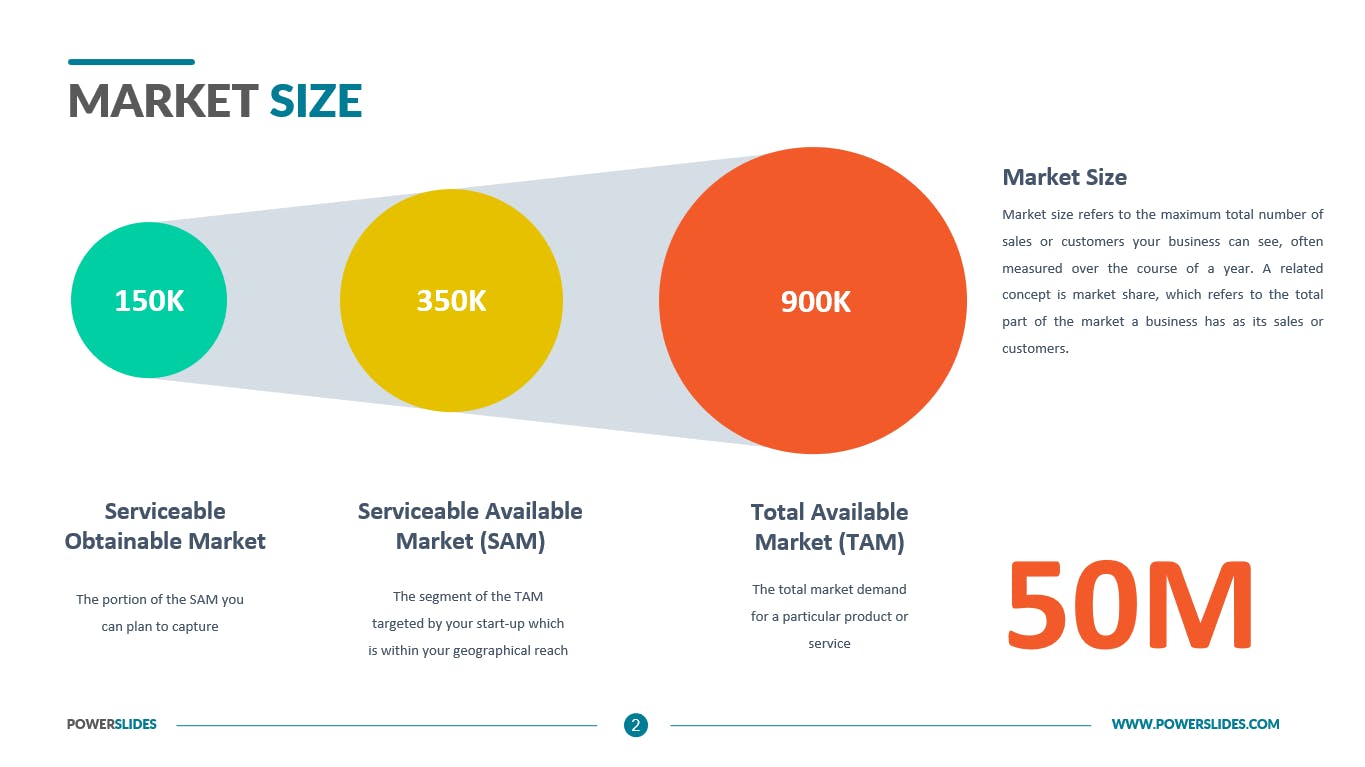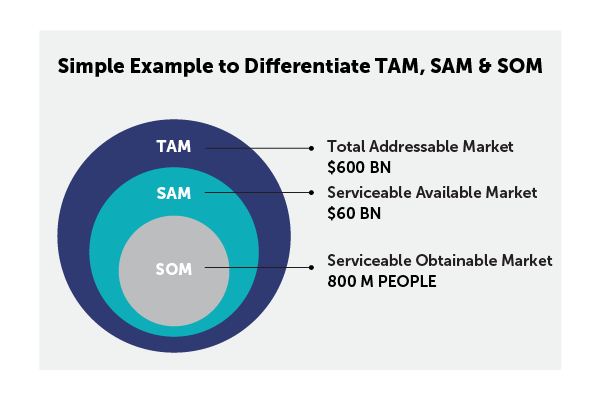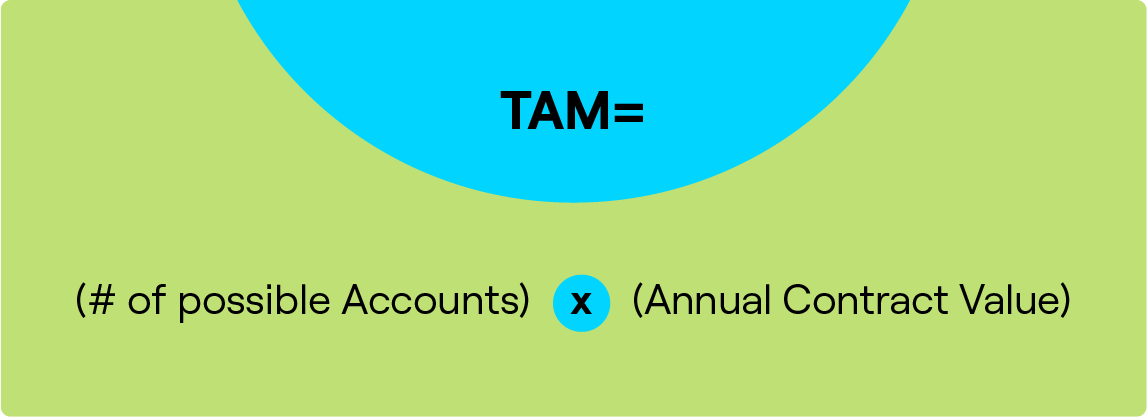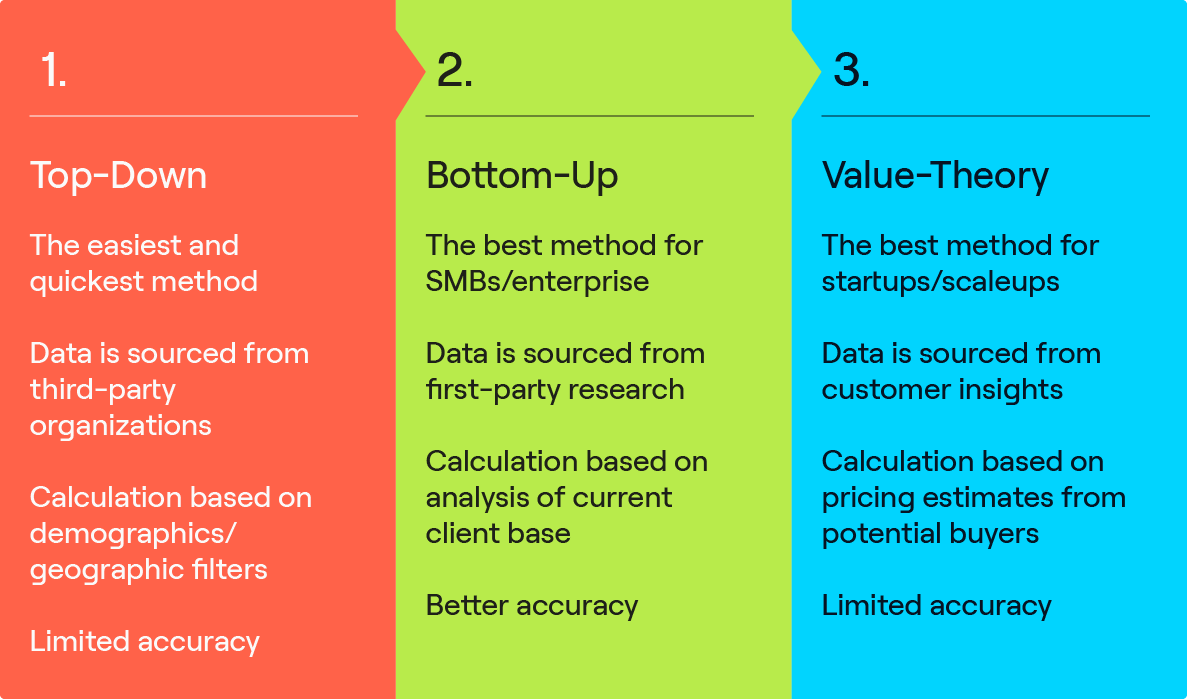Defining and calculating total addressable market (TAM)
Feb 7th, 2023

Contents
What is a total addressable market?
TAM vs SAM vs SOM
How to calculate a total addressable market?
Total addressable market examples
Calculating your company’s total addressable market is crucial in determining your business strategy and a critical element of a comprehensive business plan. TAM helps companies consider the best-case scenario for development as it outlines how much revenue a business can generate under ideal circumstances.
Once you calculate TAM, you can determine the company’s potential and revenue opportunities. It gives you an idea of your product viability. What’s more, when you know your total addressable market, you can decide which business prospects and objectives have the best chance of success and calculate how much time and money you need to win the best market share. This article will present the methods for calculating TAM and examples of measuring it for different industries.
What is a total addressable market?
Total addressable market or total available market (TAM) is the largest possible market opportunity for a specific good or service. It is the maximum amount of money a company can generate by selling a product in a specific market. This metric helps companies assess the size of a particular market, identify market demand for their products and prioritize business opportunities. In other words, the total addressable market is the overall demand a supplier could meet if there were no competitors or alternatives to a product or service.
With a total addressable market, startups can analyze the market’s potential scale and launch new products. Well-established companies and large brands can use this metric to evaluate profit potential and determine whether there is an opportunity for them to expand and increase their revenue inside the market. In addition, business owners measure TAM to determine the number of clients they can attract using their marketing initiatives and sales channels and identify the size of the target audience.
Total addressable market and total market are two different concepts. In the absence of competition or alternatives with other unique selling propositions, an entire market represents the greatest potential opportunity. The total addressable market is a small portion of this market, but it is directly related to buyer personas and potential customers.
Entrepreneurs often confuse the total addressable market with the market size. However, these concepts are different. Let us compare these terms to understand their differences and avoid misinterpretation.
Total addressable market vs market size
Market size refers to the sales volume and entire revenue generated in a specific economic sector. It is the number of potential customers for a particular product over a specific time, usually a year. For example, the market size of digital advertising in the US is expected to be $261.1 billion in 2022. This sum is the overall amount of money spent on online advertising in the past year.

In contrast, the total addressable market is the overall revenue a company can receive if it attracts every potential client. Therefore, the addressable market is unique and often smaller than the market size. While market size helps you estimate an existing customer need to effectively allocate resources and develop a marketing strategy, calculating TAM allows you to clearly understand your market share and the size of your target audience. Moreover, the total addressable market indicates the demand for particular products and services and provides information about your company’s business growth and potential future earnings.
In the following paragraphs, we will describe the total addressable market in more depth. We will also discuss different market size estimates, such as serviceable available market and serviceable obtainable market.
TAM vs SAM vs SOM
The total addressable market represents the overall market environment. It is measured in annual revenue or unit sales if a business serves 100% of the available market. However, your company will not function as a monopoly if you have competitors. So you need to divide TAM into smaller parts. As a result, your market share is the fraction of TAM that is left over.

Serviceable available market (SAM)
Different businesses might cater to particular TAM market segments. Each segment is a sub-market that caters to different types of customers. This sub-market is called SAM or serviceable available market. Therefore, SAM refers to the fraction of the total addressable market that can be reached by a business and potentially served by its products and services. According to the other definition, SAM is a potential audience for a product.
SAM is the portion of the total addressable market that needs the company’s offerings and could become customers in the nearest future. The factors that narrow down TAM to SAM include product functionality, quality, price, and financial and competitive limitations. Moreover, the serviceable available market can be defined by geographical, cultural, and regulatory considerations.
For example, if you sell Bluetooth headphones in the US, your TAM would be the global headphones market, while your SAM is the Bluetooth headphones market in the United States. The amount of income you can realistically expect to make from a product depends on the size of the serviceable available market. Furthermore, SAM can help you determine your niche market by differentiating customer segments according to demographics, location, and other characteristics.
Serviceable obtainable market (SOM)
If your company is an early-stage startup, reaching the entire serviceable available market would be difficult. Hence, you need to identify the fraction of SAM that you can target in 3-5 years with your current resources. This market fraction is called SOM or serviceable obtainable market. SOM is the largest potential market you can attract, taking into account your competition, staff, funding, brand awareness, and location. Using our previous example, SOM is the fraction of the Bluetooth headphones market in the US that you can acquire when you consider your rivals who sell the same product in the United States.
By calculating SOM, you can set realistic objectives for your business and present them to investors. To access a serviceable obtainable market, you need to analyze competitors in your niche and estimate the total niche volume. Then you should compare your product, product marketing strategy, and pricing to determine how much market share you can reach. In addition, you can use frameworks like Porter’s Five Forces to understand market dynamics.
Once you are familiar with these metrics, you should begin by calculating the total addressable market to have a general picture of the competitiveness of your product on a global market.
How to calculate a total addressable market?
There are four basic ways of calculating TAM: three primary research methods and one secondary research method. We will explain each of these methods in greater detail below.
External research
External research or third-party analysis is a secondary research approach. It uses data already gathered by professional research firms. Although private research studies are expensive, their headline figures are occasionally released to the general public via press releases. You can also find industry reports that typically include data on revenue opportunities and prospects for the future on the platforms like Gartner, IDC, and Forrester.
This calculation method is easy to implement. The data is credible as qualified experts collect it. However, the disadvantage of this method is a need for more transparency concerning the approach to calculating the estimate. Thus, it would be difficult to prove the origin of data when speaking to investors. You will have a better knowledge of the figures and strengthen your negotiating power if you calculate TAM on your own.
Top-down approach
A top-down approach is when you first look at the entire market and then focus on the area relevant to your business. This method seems intuitive for many entrepreneurs as you start with the population and then exclude unessential segments using geographic, demographic, and economic deductions.
You can find necessary macroeconomic data and accurate statistics on The World Bank, OECD, and CIA’s World Factbook. First, you need to start with the overall market size, then limit the market size to the amount spent on your industry. The next step is to narrow the market even more to your category. Finally, you can segment the market further if necessary. Here is the formula for calculating TAM with the top-down approach:
TAM = number of prospective clients x revenue per consumer
For example, a technology startup that provides an application for businesses with a limited budget takes into consideration industry analysis that reveals that there are 1 million companies, 30% of which do not have access to expensive accounting applications. A 20% access rate multiplied by 1 million consumers equals 200,000 prospective clients. According to a study, 90% of companies that do not use premium accounting software hire a full-time in-house accountant. As a result, there are now 20,000 potential buyers. The projected TAM is $2 million if the company provides the software for free but charges $100 a year in subscription fees (20,000 x $100).
Bottom-up method
Most investors use the bottom-up approach as it tends to be more accurate regarding the actual market size. The company uses data from its study or survey; therefore, TAM would be more relevant. The advantage of using a bottom-up strategy is the opportunity for a business to justify why it chose some client segments and ignored others. This method provides a better understanding of economic forces, consumer segments, market opportunities, and limitations.
The bottom-up TAM method multiplies the total number of prospective accounts by the annual cost of your product or service. To calculate the total addressable market, you need to choose a target market, count the number of potential customers who meet your requirements, and multiply the number of prospective clients by the average deal size. In addition, consider potential target market segments, distribution channels, and a portion of the market you can attract. The bottom-up method's formula for TAM is as follows:
TAM = number of prospective consumers x annual value of the contract

For example, you are a SaaS company with 5.2 million potential customers for your B2B product. If the annual contract price equals $120, then the total addressable market will be $624 million (5,200,000 customers x $120).

Value theory method
Value theory estimates the value product provides to users and how many potential customers are ready to pay for the evolution or advancement of the product. Then, a business determines how much value the offering can add and how the pricing would reflect this value. This approach is suitable for companies when a company launches new products or cross-sells particular products to current clients.
For example, if your company is a music streaming service like Spotify, you need to determine a fixed price to purchase music. However, instead of buying a song, the potential customer gains access to a vast music collection, adding value to the product, and a typical monthly price of $9.99 will seem reasonable. Therefore, to measure TAM, you need to attach the pricing to the number of users instead of calculating the amount of money music listeners spend on downloaded songs. Here is the TAM formula for the value theory method:
TAM = number of prospective consumers x cost per unit of a product
To dive deeply into this topic, we will present other examples of the total addressable market for different companies in the following section.
Total addressable market examples
Let us consider three examples of TAM to understand what a total addressable market is and what it is not.
Smartphone manufacturer
If you are a smartphone manufacturer operating in the US, your TAM would be the number of smartphone users in the United States which may be 80% of the total population. At the same time, if you have four competitors in the market and all have equal market share, your SAM will be 20% of the market.
B2B startup
If you are a company with 10,000 customers and you can charge $10,000 annually, your total addressable market will comprise $100 million. Thus, your business objective will be to reach the total addressable market of $10 to $100 million using your B2B marketing strategy. If your beachhead market is more significant, it makes sense to segment it further. In the opposite case, it is not worthwhile to target this market because it's very optimistic to believe you'll capture 50% of it.
Laptop seller
For example, your company is a laptop seller. Your TAM will be the entire number of people who purchase a laptop in one year, which is about 60 million consumers in US. If your company holds 50% of that market share, you can reach 30 million consumers. If two other laptop sellers have 20% of the market share, they can target 15 million buyers.
Launching a startup and predicting its growth for the following year is always exciting. First, however, you need to set realistic objectives to achieve success. Calculating TAM is the best way to analyze your future perspectives and persuade potential investors that you understand the industry and are ready to promote your products effectively.
